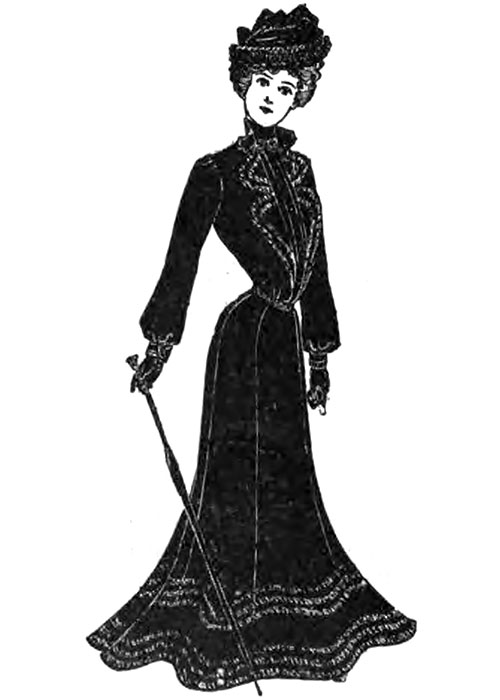Mourning Dress for Women - 1902
Guide to Appropriate Attire During Mourning Periods, including First Mourning Dress, Mourning Attire for different relationships, and Inappropriate Mourning Clothing and Accessories.

A Mourning Costume from 1901. The Delineator, May 1901. | GGA Image ID # 2178e1799a
First Mourning Dress for a Widow
The first mourning dress for a widow typically consists of a black worsted skirt and waist, which are simply trimmed with folds of gowns. During this time, she wears only black dresses, along with white muslin wrist and throat bands, black gloves, and a purse. She also uses very little jewelry, if any at all, and what she does wear is very simple.
If a widow decides to stop wearing mourning attire, she can wear a crepe bonnet, long veil, and crepe-trimmed gowns for a year. After this, she can wear black costumes made of crepe de chine, lusterless silk, etc. These dresses can be paired with hats and bonnets that are adorned with black ribbon and black flowers, black chiffon, and dull jet ornaments.
Once six months have passed, white and lilac touches can suitably relieve the second mourning, and after two years have expired, colors may be resumed.
Mourning the Loss of Her Child, Sister, Brother, or Parent
When a married woman is mourning the loss of her child, sister, brother, or parent, she wears the same dress as she would wear in the case of widowhood. However, the only difference is that she should not wear a white bonnet ruché, which is the unmistakable symbol of widowhood.
She should wear her sable raiment for at least one year, but it is considered good taste to move to second mourning after a year and a half and not wear completely black clothes until two years have passed.
For infants, some mothers choose not to wear black clothes at all, as it is a profound sorrow. If the bereaved parent has other young children, it is kinder to them to wear as little funeral black as possible.
Mourning the Death of a Mother-In-Law or Father-In-Law
When mourning the death of a mother-in-law or father-in-law, it is customary to wear black without crêpe for one month. After that, it is appropriate to introduce white and lilac with the black.
During second mourning, young women may wear white with mourning ribbons in the summer season. In the case of middle-aged unmarried women mourning for parents, sisters, or brothers, they should wear the same attire as a married woman mourning for any of these relatives.
For mourning an aunt, uncle, or grandparent, the appropriate dress code is pure black without a touch of crepe, worn for three months. It's acceptable to wear ordinary jewelry that is not too conspicuous with this dress.
Mourning Attire
When it comes to mourning attire, a simple black outfit worn for three weeks is sufficient for a first cousin. However, after the first month, few people continue to wear black. Instead, it is recommended to wear black and white or gray, brightened with lilac for two to three weeks.
Mourning attire is not usually worn for brothers-in-law, sisters-in-law, aunts-in-law, uncles-in-law, or a husband's grandparents. If a young unmarried woman loses her parent, sister, or brother, she should not wear a black bonnet and veil to mourn. Instead, it is appropriate to wear a hat trimmed with crepe and a small face veil made of plain black net with a broad border of crepe.
A worsted gown trimmed with folds of crepe, black gloves, handkerchiefs with delicate ornamental black borders, and dull jet ornaments or none at all make the proper costume for the first six months to a year. After that, it is recommended to dress in attire suitable for cousins.
Inappropriate Mourning Clothing and Accessories
It is inappropriate to wear crepe, a type of mourning fabric, after the death of anyone other than an immediate family member, unless the uncle, aunt, grandparent, or cousin was very close to the mourner. In such cases, the mourner may experience the same level of grief as they would for a parent, sibling, or child, and thus may wear mourning attire for the same length of time.
Children under the age of fifteen should not wear mourning attire, and girls under seventeen should not wear crepe. When a young girl loses a parent, sibling, or child, she should wear a black felt or straw hat with simple lusterless ribbon bows. Her dress should be black, with white accents around the waist. She should not wear jewelry, but she does not need to carry a black-bordered handkerchief.
Banks, Charles Eugene, Beautiful Homes and Social Customs of America: The Blue Book of American Culture, Chicago: The Bible House, Publishers, 1902, p. 306-308.
The illustration is from "Mourning Styles and Customs: Mourning Costume MC7", in the Delineator, Paris-London-New York: The Butterick Publishing Co. Ltd., Vol. LVII, No. 5, May 1901.
